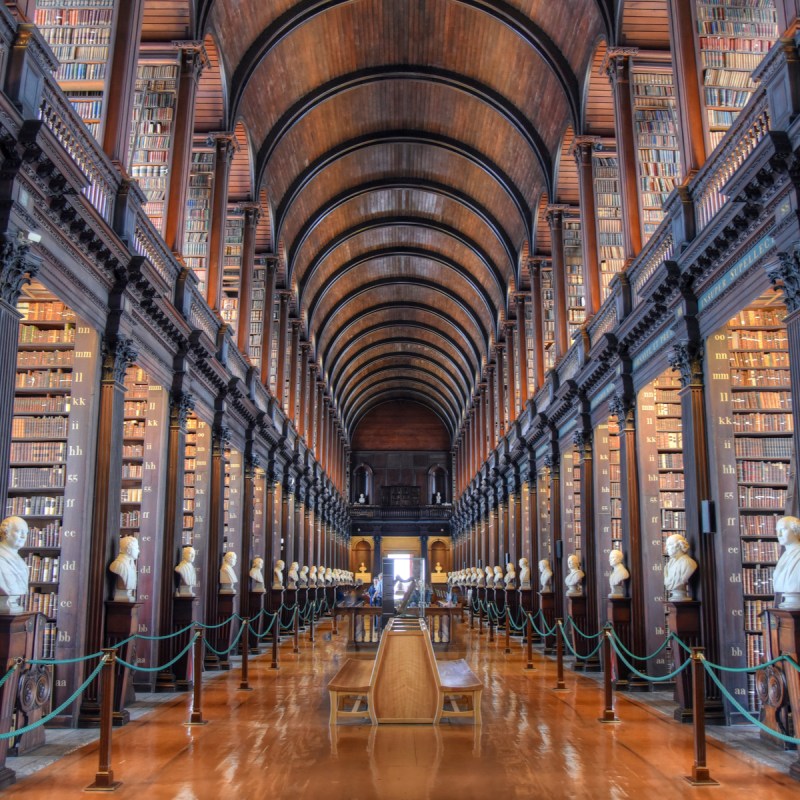
Dublin, the capital and largest city of Ireland, established on the banks of the River Liffey and the lesser-known River Poddle, more than 1,000 years ago, spans both centuries and miles of history.
Videos by TravelAwaits
Like 10 percent of Americans, I’m part Irish. With each visit, I find something new about Irish life. The deep history of the country leaves plenty to explore.
1. Trinity College, Dublin
The Book Of Kells
When most people think of historic Dublin, they think of the Book of Kells. Kept within the same building as Trinity’s Long Hall, this attraction can take you 3 hours or more if you read all the signage.
The illuminative manuscript contains the four gospels and is thought to have been created around 800 A.D. You can find a digital version here.
Once done, go up another flight of stairs to one of my favorite places in all of Ireland:
The Long Room
This library has 51 marble busts lining either side of the path that holds one of the few remaining copies of the 1916 Easter Rising freedom declaration
2. Dublin City Hall
Now restored to its original splendor, the architecture of City Hall impresses with its sheer size and sumptuous fittings. The spectacular entrance hall and rotunda are the perfect setting for weddings as well as city and state events.
Look down on the lower levels, and you’ll find “vaults” filled with multimedia exhibits that highlight key elements of the history of Dublin, from poster presentations to architectural models to film presentations.

3. Dublin Castle
Erected on the site of a Viking settlement in the early 13th century, Dublin Castle served as headquarters of English, and then British, administration in Ireland. In 1922, following Ireland’s independence, Dublin Castle became an Irish government complex and key tourist attraction.
When you find the nearly hidden entrances to this extensive estate, you’ll be impressed by the courtyard, the tower, the stateliness of its own private Chapel Royale, the underground portions that reveal part of the River Poddle and, of course, the physical presence of the castle itself.
During the tour, you’ll see the public dining room and St. Patrick’s Hall where a change of government administrations and other state ceremonies continue today.
And behind the castle, you’ll find a secret garden that encompasses the Garda Memorial, an exhibit building, and the entrance to the world-renowned Chester Beatty Library.

4. Dublinia
Dublinia, the Viking and medieval museum, is attached to Christ Church Cathedral across the skywalk.
Here, you can visit a Viking house on a Viking street, a medieval merchant’s house, and the medieval fair — even costumes to try on. Artifacts from the battle of Clontarf, death, and disease are all explored in the museum.
Take the time to climb the 96-step medieval St. Michael Tower for awesome city views. Then walk across the sky bridge and down the stairs to enter Christ Church Cathedral.
5. Christ Church Cathedral
At the beginning of Dublin’s walled city status, Christ Church Cathedral was within the wall, St. Patrick’s outside. That’s how there are two cathedrals in one city. Now both Anglican, the archbishop’s chair remains at Christ Church. The cathedral was saved from ruin in the 19th century by the Roe Distillery’s Henry Roe.
At one point, the crypt was used as a marketplace and bar. Now it’s used for tours and sometimes for TV shows like The Tudors. The most important document in the crypt must be Ireland’s copy of the Magna Carta.

6. St. Patrick’s Cathedral
The other famous religious tourist attraction, St. Patrick’s Cathedral, is about a 10- minute walk from Christ Church. Built in honor of Ireland’s patron saint, it stands adjacent to the famous well where tradition says Saint Patrick baptized converts on his visit to Dublin.
Included within this grand cathedral are 39 stained glass windows and three statues representing St. Patrick. Legend has it that he used the shamrock to represent the Holy Trinity — Father, Son, and Holy Spirit. There’s no evidence that snakes ever existed on Irish shores, but their absence is also attributed to him.
Multiple altars, a new organ up a winding staircase, and a change in architectural style was agreed to when Sir Benjamin Lee Guinness, grandson of Arthur Guinness, made his financial support for renovation conditional upon his being able to design it.
One of the stained-glass windows on the very forward chapel is an image of his daughter, Anne. She married one of the ministers here, but it always struck me as clever that hers says “Let them have drink” — very appropriate for a Guinness lass.
7. The Chester Beatty Library
Containing the widest collection of religious manuscripts, this library is world-renowned for its excellence and scholarship. Chester Beatty was an American, a mining engineering expert, who toured Europe, Africa, and Asia and collected religious manuscripts. He ultimately emigrated to Ireland where he became the first non-Irish citizen to receive citizen status and a government burial at Glasnevin cemetery.

8. Kilmainham Gaol
This former prison, Kilmainham Gaol remains one of Dublin’s most popular tourist attractions.
It’s most famous, perhaps, for the imprisonment of so many who fought for Irish freedom in the 18th, 19th, and 20th centuries.
The execution of the 1916 Easter Rising leaders here led to the change in American and British sentiment that led to Ireland’s independence.

9. Guinness Storehouse
One of the most popular tourist experiences is a visit to the Guinness Storehouse. The story of Olivia and Arthur Guinness and their creation and expansion of this most popular beverage embrace the heart and soul of Ireland’s entrepreneurship. In 1759, Arthur signed a 9,000-year lease and began to brew ale.
The process has been improved with modern technology, but the essence of the formula remains intact.
10. Farmleigh
The official Irish State guesthouse, built in the late 18th century and purchased by Edward Guinness in 1873, first Earl of Iveagh, and great-grandson of Arthur Guinness, Farmleigh holds important art collections and the Benjamin Iveagh collection of rare books.
The estate covers 32 acres and includes walled and sunken gardens, with scenic lakeside walks.
11. Richmond Barracks
In Dublin 8, Richmond Barracks played a key role in the lives of soldiers and civilians who passed through over the past 200 years. The 1916 Rising rebels were held here before being transferred to Kilmainham Gaol.
Take the time to stroll through the War Memorial Gardens. The names of nearly 50,000 soldiers are contained in the granite book rooms in the gardens.
12. The Four Courts
Home of Irish Law, the Four Courts were originally housed in Christ Church Cathedral. Outgrowing the site, James Gandon designed the building that houses the Supreme Court, the High Court, and the Dublin Circuit Court.
During the 1916 Easter Rising, it was used as the headquarters of Commandant Ned Daly and the 1st Battalion during some of the most intense fighting. Much of the building was destroyed during the Civil War in 1922.

13. Ha’Penny Bridge
Built in 1816, crossing the River Liffey is a walk across history. This pedestrian bridge earned its name from William Walsh, a ferryman who built the bridge and charged a ha’penny toll to travelers who wanted to cross. This toll existed for 100 years.
14. Daniel O’Connell Monument
Daniel O’Connell referred to as “The Liberator,” or “The Emancipator,” was an Irish political leader in the early 19th century who campaigned for Catholic Emancipation. His work returned the rights of Catholics to enter politics and become Members of Parliament.
15. Glasnevin Cemetery Museum and Guided Tours
Ireland’s largest cemetery, over 1.5-million people are buried in Glasnevin. From Daniel O’Connell and Chester Beatty to other dignitaries and solid citizens, this Victorian garden cemetery covers 124 acres and is attached to the Botanical Garden.
Stop at the gravediggers’ bar. Sharing a common wall with part of the cemetery, legend had it the gravediggers would knock on the wall for a pint. There is no “window” from the graveyard to the Kavanaugh’s Gravediggers Pub, but it’s a minute’s walk from the Prospect Square entrance.
16. The Famine Statues and the Jeanie Johnston
The Famine statues on Custom House Quay sculpted by Roan Gillespie in 1997 are placed where one of the first voyages of the Famine period departed from this quay in 1846. To see what life was like on board at this time, visit the Jeanie Johnston famine ship located near this memorial and take a guided tour of a replica ship from this period. You’ll learn the history of this very successful ship and learn of the lad with 26 names.

17. EPIC The Irish Emigration Museum
This leading European tourist attraction covers the history of Ireland and the positive impact Irish emigration has had across the globe. It’s an interactive experience so no one will be bored. It features personal stories of adventure and adversity, love, loss, and triumph.
18. The Custom House
The Custom House is the most stunning building on the north bank of the River Liffey. A neoclassical 18th-century building, it now houses Irish Government departments. Designed by James Gandon in 1781, it was burned down during the War of Independence in 1921 and restored after the Anglo-Irish Treaty.
While exploring Dublin, investigate these other interesting Ireland destinations:
